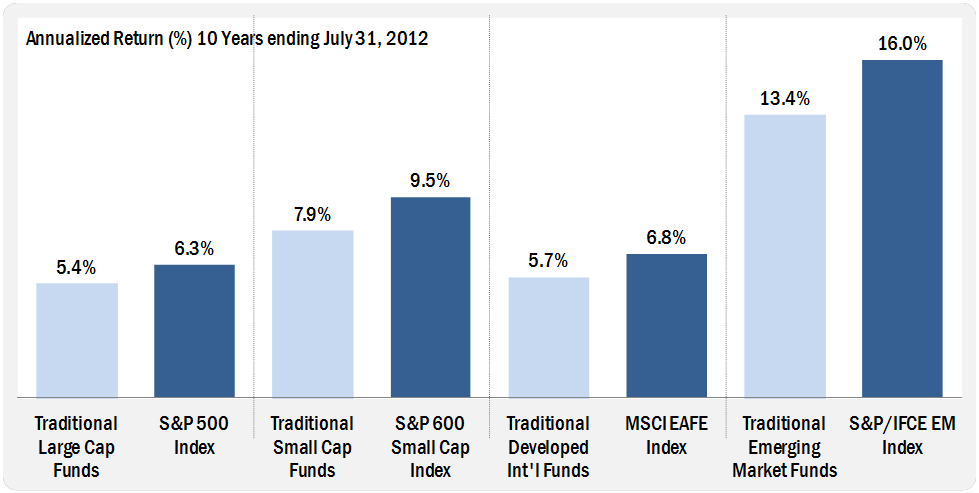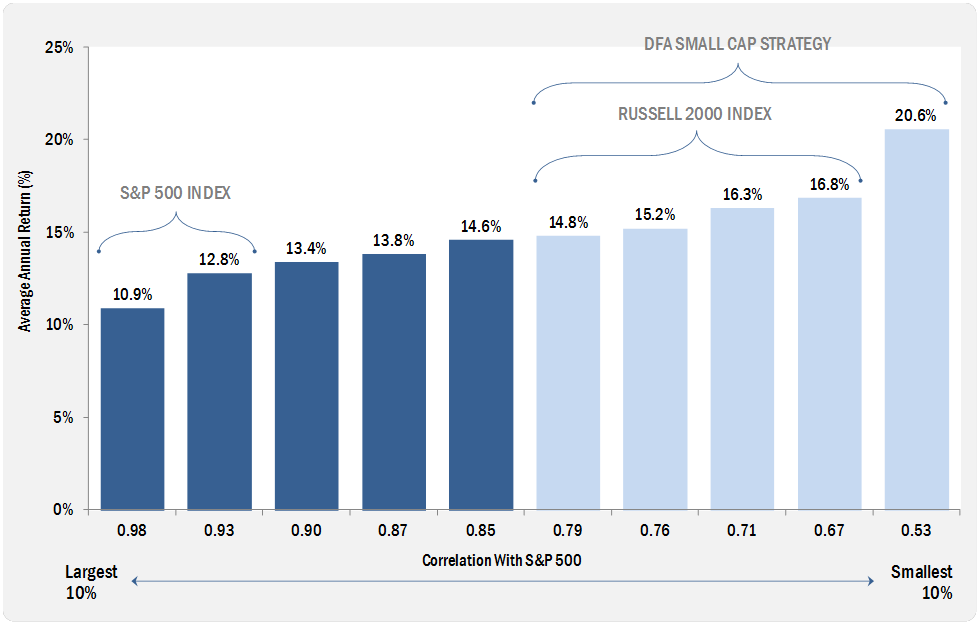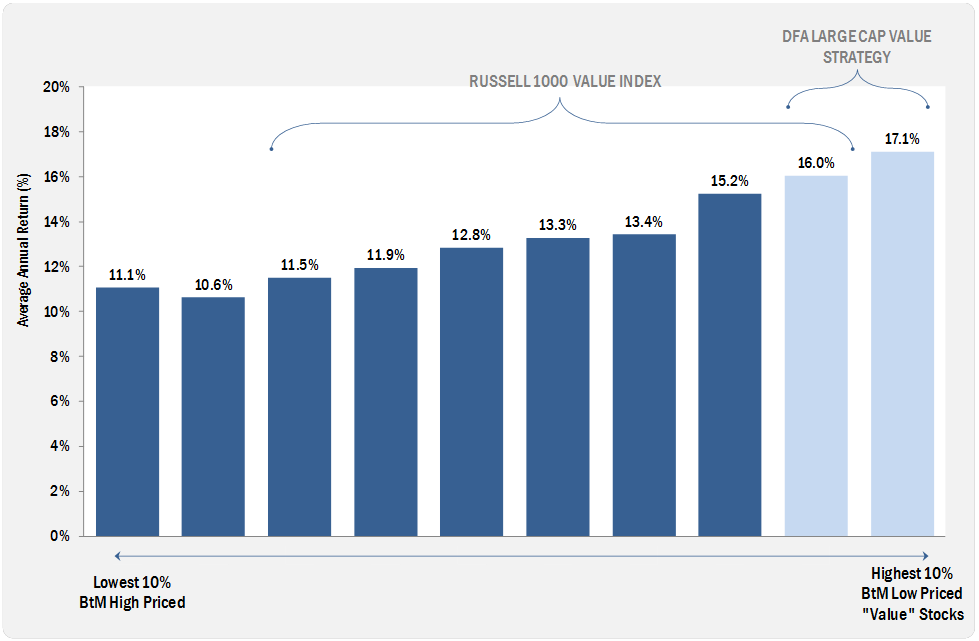Traditional Funds vs. Index Funds vs. Enhanced Index Funds
A common investment myth, among professional and non-professional investors alike, is that with easy access to copious amounts of financial and economic information, it is easy to determine to some extent, where markets are going and profit accordingly. This is evident from the large amount of money that is invested in traditional, non-index funds versus what is invested in index funds. Currently, of the approximately $6 trillion invested in total mutual funds, only $1.26 trillion (or 21%) is invested in index funds.
Consider the following example from Weston Wellington of Dimensional Fund Advisors: Suppose 70 years ago you were given $1,000. If you had put that money in a savings account, it would have grown to over $16,000. However, if you had invested in the S&P 500 Index, you would now have over $1.8 million, and if you had invested in an index of small companies, you would have over $12 million. If you were lucky enough to have perfectly timed the market (i.e., buying at the start of every bull market and selling at the top), you would have earned over $7.2 billion. It is this irrational hope that triumphs over reason, giving many investors the illusion they could be so lucky. But why is it so hard for experts and individuals to predict the market?
One reason has to do with the flow of information. As new information is made public, it is automatically incorporated into stock prices. This means that once the news is out, it is too late to gain any benefit from it. What matters then is future news, relative to what is expected (based on the old news). It is the change in expectations that changes stock prices. In other words, if the latest news is better than expected, prices will rise, and if the latest news is worse than expected, prices will fall. It is predicting this change, relative to expectations, that makes predicting the direction of the stock market so difficult.
Unemployment peaked at 10.1% in October, 2009. As of February 2013, the unemployment rate only decreased slightly to 7.7%. However, during this same time period, the S&P 500 has increased over 43%. This illustrates how, with investing, it’s not the news itself that matters (indeed there is still a lot of other bad news out there), it’s the news relative to what is expected that drives stock prices and market movements.
One of our favorite authors, Larry Swedroe, is fond of saying that when things look darkest, stocks tend to have good returns. Our own research indicates that when the unemployment rate is below 4% the average return on the S&P 500 is 6%, the unemployment rate is above 6%, the S&P 500 returns an average of 17%. This result is very counterintuitive, but does shed light on the difficulties faced with correctly predicting markets.
In spite of some of the obvious difficulties involved in correctly predicting the future, much advice is still given on the subject. One has to look no further than the financial press to find out “what investors should do now.” Below are some examples.
- A January 2002 article in the investment publication Pensions & Investments highlighted the predictions of 19 money managers who unanimously predicted positive returns for stocks in 2002. The Dow Jones closed down -22% that year.
- Bill Gross (who manages the world’s largest bond fund for PIMCO) is not immune to getting it wrong. In September 2002, with the Dow Jones trading at 8,663, Bill boldly predicted that the Dow Jones would fall to 5,000 (the Dow Jones hit market bottom on October 9th 2002 at 7,286).
- In the February 7, 2005 edition of The Wall Street Journal, “experts” were asked to pick their 10 favorite stocks and their 10 least favorite stocks for 2005. The “favorite” 10 did well, returning 13% for the year, but were outdone by the least favorite stocks which returned 19% for the year.
- In the June 1996 edition of Worth Magazine, the cover declared “Found: The Next Microsoft”. It turned out the “next Microsoft” filed for bankruptcy in 2001.
- A Money Magazine article from August 1997 told investors to “Sell Stocks Now!” The Dow Jones increased by more than 40% from the date of the article to December 1999, according to google finance. Just in time to have Money Magazine begin recommending tech stocks at the peak of the tech bubble.
- On October 10, 2002 The Wall Street Journal headline read: “Bears Claw Markets Yet Again, As Dow Industrial Falls Nearly 3%.” On the same day, the Wilmington Trust said “Terrorism…..war….falling earnings estimates. Right now there doesn’t seem to be any reason to buy stocks.” That was the precise day the market hit bottom and proceeded to gain 969 points over the next four trading days.
Checking mutual fund ratings services as a source of information is also unlikely to lead to better results. Depending on which ratings service you review, the advice will be different. For example, during December 2000 to January 2001 the same mutual fund received a score of 93/100 from US News and a rating of “D” (on an A-F scale) from Forbes, as well as several scores in between from other ratings providers. Of course, a mutual fund cannot simultaneously be both a “good” and “bad” investment. This shows how highly subjective the mutual fund review process must be.
So, how does an investor find objective advice? We suggest reviewing work done by PhD’s in finance or economics that are published in one of the peer-reviewed investment journals such as the Journal of Finance or Financial Analysts Journal. It is this “peer-reviewed” process which makes the conclusion highly credible. As scientific studies are submitted to be published, editors send it out to other scholars in the same field to get their opinion on the quality of the scholarship, the method, and conclusions reached. Most other publications are not “peer-reviewed,” and instead rely on the judgment of the editors and publishers, whose motivations are not what you might think.
Consider this quote from the publisher of Forbes Magazine, Steve Forbes. The implications for investors are obvious:
You make more money selling advice than following it. It’s one of the things we count on in the magazine business – along with the short term memory of our readers.
The main purpose of most magazines is to sell issues, not provide objective investment advice. At Empirical, it is our job to examine the evidence and make recommendations to you based on sound research and academic papers.
Here is a small sample of the research we considered in developing our investment philosophy:
1968
Michael Jensen publishes “The performance of mutual funds in the period 1945-1964” in the Journal of Finance 23, no 2 (May 1968). Examines 115 equity mutual funds covering 1945-1964. He finds “very little evidence that any individual fund was able to do significantly better than that we would expect from mere random change.”
2001
James Davis publishes “Mutual Fund Performance and Manager Style” in the Financial Analyst Journal. January/February 2001. Finds that “none of the styles included in the study are able to generate positive abnormal returns, compared to the benchmark.”
2003
Vanguard publishes “Sources of Portfolio Performance: The Enduring Importance of Asset Allocation.” The authors confirm original research performed by Brinson, Hood, & Beebower, which concludes that asset allocation (the selection of which asset classes to include in a portfolio) is the dominant influence on total returns, and that market timing and stock selection (traditional approaches) play minor roles and detract value.
2008
Barras, Scaillet, & Wermers publish “False Discoveries in Mutual Fund Performance: Measuring Luck in Estimated Alphas” in May, 2008. Covers 2,587 mutual funds from 1975-2006 and conclude that only 12 of 2,587 (or 0.6%) of fund managers exhibited skill in security selection.
2012
The Center for Research in Security Prices tracks the performance of non-index mutual funds for the 10 years ending December 31, 2011 and finds that 80% of the traditional mutual fund managers failed to outperform their appropriate index. Failure rate among bond funds is 89% for the same period.
So far, we have examined some anecdotal evidence from investment publications and reviewed a short list of “peer-reviewed” scientific studies on the subject. What about the actual returns between traditional mutual funds and index funds?
Figure 1: Traditional Managed Stock Funds Failed to “Outperform the Market”
Source: Morningstar Direct. Active fund returns are category average
So, if traditional approaches don’t outperform the index, should you just buy an index? Absent evidence to the contrary, the answer would be yes. However, before we make this conclusion, let examine all the evidence. Is there a way to outperform traditional indexes? Based on historical returns, the answer is yes, and it is called Enhanced Index Investing.
Enhanced index investing attempts to apply standards of evidence gained from the application of the scientific method, and uses this knowledge in an attempt to outperform conventional indexes.
Eugene Fama and Kenneth R. French co-authored a study called “The cross-section of Expected Stock Returns” that demonstrated how equity portfolio returns are driven by the amount of large stocks versus small stocks & the amount of Value versus Growth stocks held in a portfolio. The implication is enormous for investors. The study shows that an investor can improve on an already solid index strategy by adding more small company and low priced (value) stocks to their portfolio.
Figure 2: US Market Capitalization – By Deciles: 1926-2012
Source: Market cap decile data provided by the Center for Research in Security Prices, University of Chicago. The S&P data are provided by Standard & Poor’s Index Services
Another way to look at this relationship between company size and performance is detailed in Figure 2. We have the entire US stock market divided into 10% units (called deciles) ranked by company size (largest to smallest), and the table covers the returns of these companies from 1926-2012. You can see the relationship between the average return to the size of the company. The largest 10% of companies have averaged 10.83% per year since 1926 and the smallest 10% of companies have averaged 20.54% per year since 1926. Of course this additional return comes with more risk, but knowing this, what types of stocks would you want to have in your portfolio?
The same relationship exists when it comes to low priced (value) stocks and high priced (growth) stocks. Here, in order to determine which stocks are the high priced (growth) stocks and which are the low priced (value) stocks we use a Book to Market ratio. This ratio describes the “book value” versus the “market value” of a stock. The “book value” is the net asset value of the company on the company’s own balance sheet and the “market value” is the value of all the outstanding shares. When organized this way, the difference in returns becomes obvious. The more exposure you have to “value” companies, the higher your expected return. You can see this relationship in Figure 3 below. The stocks with the highest Book to Market ratio have historically delivered a significantly higher return.
Figure 3: Low Priced (Value) Stocks vs. High Priced (Growth) Stocks: 1927–2012
Source: Book-to-market decile returns provided by French/Fama from data from Center for Research in Security Prices, University of Chicago. Russell data provided by Russell Investment Group.
An example will help make this concept easier to understand. The Vanguard S&P 500 Index (VFINX) has 508 stocks. The top 10 stocks make up 20% of the entire fund because the largest companies take up the most “room” in the index. This method is called market capitalization weighting. If maximizing your investment return is important, and we expect that smaller companies will offer better returns; this is the exact opposite of what an investor would want in their portfolio. Combined, these two principals lead us to the main drawback of index funds; they are specifically constructed so that the largest companies (rather than the smallest) and more “growth” companies (rather than “value” companies) comprise a greater proportion of the fund.
Similarly, if exposure to “value” companies is expected to deliver a higher return, than it is important to target stocks that have the highest book to market ratios.
The other main drawback with an index fund is index fund reconstitution. This is the regular process by which stocks are added or subtracted from the index. The index fund committee gets together annually and decides which stocks to remove and which to add to the index. Afterwards, they announce the upcoming changes and the effective date. During the period between the announcement and the effective date, the index fund managers make the changes. What happens to the price of the stocks being removed or added to/from the index? The stocks being added increase in price and the stocks being removed decrease in price– the exact opposite of what an index shareholder would want.
Further, index funds generally reconstitute once a year. This is a problem because many stocks in the index may graduate outside of their target range during the year. For example, if you are looking at a small company index fund, the percentage of the index fund that is invested in small companies ideally would be 100%. However, because the index fund is only reconstituted once a year (rather than on an as-needed basis), at any given point during the year, the index fund could contain significantly less than 100% exposure, as they would be stuck holding stocks of firms that may no longer be categorized as small companies. If maximizing return is your objective, and holding consistent exposure to small company stocks has historically been the best way to do that, then holding on to stocks that no longer fit the category is detrimental.
Enhanced indexing overcomes these issues by being flexible in how they define each category. For example, the Russell 2000 index (a small company index) simply identifies the 2000 stocks that comprise the index. The enhanced index funds organize the stock market based on company size (largest to smallest) and in the case of small companies, they target the smallest 10% of securities in the market. This allows the enhanced index fund to migrate stocks in or out of the fund as appropriate during the year (instead of rigidly holding 2000 stocks and reconstituting only once a year). Due to this flexibility, the enhanced index fund can maintain consistent exposure to the targeted market segment and deliver consistently higher returns.
Your Advisor’s Role
Our role as your investment advisor is not limited to helping you focus on the “big picture.” In many ways, it is our deep understanding of the seemingly small nuances involved with investing, taxes, and retirement that collectively bring a tremendous amount of value to our clients’ lives. This “value” transcends mere dollars and cents. We expect it to translate into a more secure and confident future for each of our clients.
Download PDF Version
Disclosure
Past performance is not a guarantee of future results. Values change frequently and past performance may not be repeated. There is always a risk that an investor may lose money. Even a long-term investment approach cannot guarantee a profit. Economic, political, and issuer specific events will cause the value of securities, and the portfolios that own them to rise or fall. Because the value of your investment in a portfolio will fluctuate, there is a risk that you will lose money. The information provided herein should not be construed as a recommendation to purchase or sell any particular security or bond or an assurance that any particular security or bond held in a portfolio will remain in the portfolio or that a previously held security will not be repurchased. It should not be assumed that any of the holdings discussed herein have been or will prove to be profitable or that future investment decisions will be profitable or will equal or exceed the investment performance of the holdings discussed.




